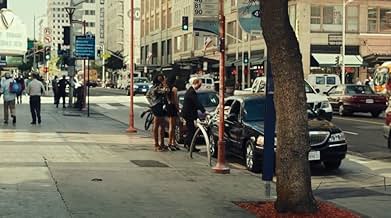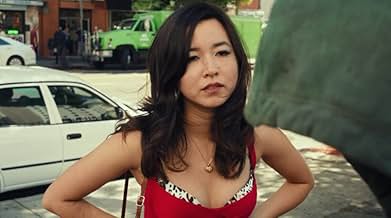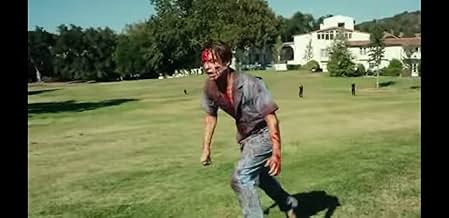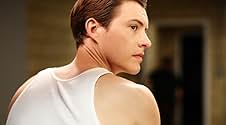IMDb रेटिंग
5.1/10
3.2 हज़ार
आपकी रेटिंग
अपनी भाषा में प्लॉट जोड़ेंA married couple of scientists create a modern-day monster.A married couple of scientists create a modern-day monster.A married couple of scientists create a modern-day monster.
- पुरस्कार
- कुल 3 जीत
Peter Adrian Sudarso
- Guard 1
- (as Peter Sudarso)
Mckenna Grace
- Molly
- (as McKenna Grace)
Ron Rogge'
- Officer Woodcock
- (as Ron Roggé)
फ़ीचर्ड समीक्षाएं
I haven't read what people are saying about this movie. I can just say that it is a 100% cruel story. It is cruel to see how everyone turns out to be a victim: the Monster, his victims and his "mother". Shocking images throughout guarantee that this movie fall into the horror category, but it is certainly not a good horror movie. In fact, it can be considered "effective" only due to the heavy use of gore and violence, but it lacks both character and story development. Also, I have some problems with the adaptation itself. For me, the monster looks more like Dorian Gray rather than Frankenstein. Similarly, the script was rather weak, though I really enjoyed the performances of Carrie-Anne Moss and Xavier Samuel. The bottom line: This movie will be good for the ones who like to suffer, but for me it is a lot of clichéd stories brought together by a very underused cast.
Bernard Rose has successfully translated Mary Shelley's original novel by turning it into a Cronenbergian body horror tragedy.
The performances are stellar with Xavier Samuel making a heartbreaking Monster and Tony Todd stealing the show as a blind musician.
The direction is superb and horror fans will be pleased by the gruesome practical effects. If there are any weak points here, it would be the extremely brisk pacing and a few odd editing decision.
The ending is also frustratingly abrupt. Beyond that, it is nothing less than a triumph of genre filmmaking and the sort of thing I wish to see more of from the horror world.
The performances are stellar with Xavier Samuel making a heartbreaking Monster and Tony Todd stealing the show as a blind musician.
The direction is superb and horror fans will be pleased by the gruesome practical effects. If there are any weak points here, it would be the extremely brisk pacing and a few odd editing decision.
The ending is also frustratingly abrupt. Beyond that, it is nothing less than a triumph of genre filmmaking and the sort of thing I wish to see more of from the horror world.
The plot was decent. It didn't always make sense but mostly worked. The problem with this film is only a string of bad things happen. So while the movie manages to be moving at times, it's a miserable experience overall. I was expecting a happy ending since the monster narrates the film and he sounds highly intelligent and sophisticated which turned out to be misleading... Bottomline, I recommend this to anyone who enjoys sad, tragic films.
This is a very interesting take on the Frankenstein tale. We get to see the Monster basically take his first breath and become born into this world. He slowly becomes accustomed to being alive when suddenly he's betrayed by his creator and thus sets about on a rampage. This film illustrates it fairly well and I feel like the character of Adam/Monster is fairly sympathetic. He lacks a vocabulary like in the novel and in the 1994 adaptation, but it's far more realistic for the vocalization capacity of a newly formed creature. Bernard Rose does a fairly good job directing and the pastoral dream sequences are nice in particular. It has a nice pace and good use of practical special effects. The Monster's transformation was thoroughly engaging and I feel if anyone is a fan of the horror genre that they should at least do themselves a favor and see this interpretation.
I skipped this small release (although it does feature recognizable actors Carrie-Anne Moss, Danny Huston and Tony Todd in supporting roles) in my survey of Frankenstein films back in 2018 during the 200th anniversary of Mary Shelley's novel, apparently, as I now know from seeing it, with good reason given that it's largely a retread of the same episodes we've seen in prior cinematic adaptations of the popular story--mainly, the 1931 Universal classic. There's the "It's Alive!" reiteration, the little girl being tossed in a lake, the mob attack and the monster threatening Frankenstein's white-clothed bride in her bedroom--none of which is actually from the book, but rather from the 1931 film. That's not to say these filmmakers didn't read the source, though, as they evidently did from some of the additions here: the blind man, the narrated philosophical musings and a fiery end closer to the original text than to James Whale's pictures.
The most readily apparent distinction of this version is, of course, how grotesque the monster is, but there are also a couple other oddities here--one of which makes me happy I saw the movie. First, the part I'm not keen on is the picture's biblical allusions. Besides the creature being named "Adam," when the Frankensteins go about trying to murder him, they strap him down in a crucifixion pose, although they employ supposedly-more-civilized means to execute him with lethal injection. Little wonder, then, whether this Christ figure will be resurrected. Come to think of it, though, the 1935 sequel "Bride of Frankenstein" also included some Christ allegory with Boris Karloff being tied up by a mob--so this part isn't even that unusual.
Yet, the dreams are something else. My ranking of Frankenstein films is now over 50 entries, and I've never seen one movie that attempted to depict in any way the disturbing and intriguing nightmare from Shelley's story. This one comes closest. In the book, Victor Frankenstein's dream of kissing Elizabeth turns into one of his embracing his dead mother. The dream here, while it plays out seemingly for more bittersweet intent and from the creature's dreaming, still manages to incorporate similar suggestions of incest and necrophilia. The Elizabeth Frankenstein in this movie, after all, is both the mother figure to the creature and the focal point of his romantic and sexual desires. Each time the monster attacks Victor Frankenstein, then, to get to the mother, it becomes an Oedipus complex. That seems more frightening to me than a guy made up to appear covered in boils.
The most readily apparent distinction of this version is, of course, how grotesque the monster is, but there are also a couple other oddities here--one of which makes me happy I saw the movie. First, the part I'm not keen on is the picture's biblical allusions. Besides the creature being named "Adam," when the Frankensteins go about trying to murder him, they strap him down in a crucifixion pose, although they employ supposedly-more-civilized means to execute him with lethal injection. Little wonder, then, whether this Christ figure will be resurrected. Come to think of it, though, the 1935 sequel "Bride of Frankenstein" also included some Christ allegory with Boris Karloff being tied up by a mob--so this part isn't even that unusual.
Yet, the dreams are something else. My ranking of Frankenstein films is now over 50 entries, and I've never seen one movie that attempted to depict in any way the disturbing and intriguing nightmare from Shelley's story. This one comes closest. In the book, Victor Frankenstein's dream of kissing Elizabeth turns into one of his embracing his dead mother. The dream here, while it plays out seemingly for more bittersweet intent and from the creature's dreaming, still manages to incorporate similar suggestions of incest and necrophilia. The Elizabeth Frankenstein in this movie, after all, is both the mother figure to the creature and the focal point of his romantic and sexual desires. Each time the monster attacks Victor Frankenstein, then, to get to the mother, it becomes an Oedipus complex. That seems more frightening to me than a guy made up to appear covered in boils.
क्या आपको पता है
- ट्रिवियाAs Wanda is searching her phone for information on Elizabeth Frankenstein, a quick shot suggests that the Frankensteins were affiliated with some corporation named Shelley. This is a direct reference to Mary Wollstonecraft Shelley, who wrote the original story.
- गूफ़At the end, Elizabeth is dead. But when Adam carries her, her arm is completely wrapped around his neck as he carries her to the fire. A dead person's arm could not maintain such a position, even if placed there by the carrier; only a live person, using muscles, would be able to keep the arm up like that. Without muscles, it would just hang down behind him. Also, as he carries her, his left arm is supporting her torso and her head is upright. Again, a head maintaining such a position would be impossible for a dead person. A dead person would have no muscles to keep a head up. Instead, it would droop backwards in the direction of gravity. Finally, as he places her down on the burning logs, her head slowly descends, whereas it should fall down, since, again, there are no working muscles to control its descent. All of this is also true if she were merely unconscious.
- कनेक्शनReferenced in The Candyman Legacy with Tony Todd (2015)
- साउंडट्रैकMannish Boy
Written by Melvin London, Bo Diddley (as Elias McDaniel) and Muddy Waters (as McKinley Morganfield)
Performed by Tony Todd
टॉप पसंद
रेटिंग देने के लिए साइन-इन करें और वैयक्तिकृत सुझावों के लिए वॉचलिस्ट करें
- How long is Frankenstein?Alexa द्वारा संचालित
विवरण
- रिलीज़ की तारीख़
- कंट्री ऑफ़ ओरिजिन
- आधिकारिक साइट
- भाषा
- इस रूप में भी जाना जाता है
- Франкенштейн
- फ़िल्माने की जगहें
- उत्पादन कंपनियां
- IMDbPro पर और कंपनी क्रेडिट देखें
बॉक्स ऑफ़िस
- दुनिया भर में सकल
- $2,53,514
- चलने की अवधि1 घंटा 29 मिनट
- रंग
- पक्ष अनुपात
- 1.78 : 1
इस पेज में योगदान दें
किसी बदलाव का सुझाव दें या अनुपलब्ध कॉन्टेंट जोड़ें


































